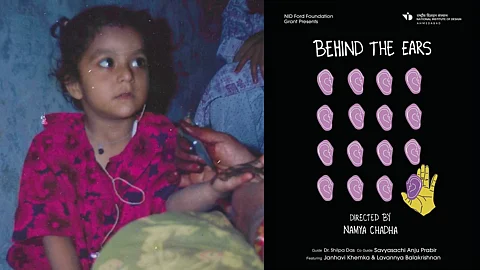
- HOMEGROWN WORLD
- #HGCREATORS
- #HGEXPLORE
- #HGVOICES
- #HGSHOP
- CAREERS
- ABOUT US
- CONTACT US

The first time Namya Chadha a filmmaker and photographer from Meerut, wore a hearing aid, the ceiling fan roared to life. Her father’s voice sounded unfamiliar, almost foreign. Even her own voice startled her. It was clearer; sharper; not quite the one she had known all her life. This intimate relearning of the world and her own self, coupled with the sonic realities of women like her, is what 'Behind The Ears', her documentary is built upon. Through the intertwined lives of Janhavi, Lavannya, and Namya herself, the film offers a quietly affecting meditation on identity, communication, and the lived experiences of people with an invisible disability.
The documentary unfolds as a series of intimate conversations. Janhavi, a contemporary artist, recalls growing up learning language differently, with each word carefully taught by her mother as a distinct combination of sound and meaning. This early negotiation with language echoes in her art today: through video works where Siri cannot recognise her voice, or performance art based centered on shared encounters. Lavannya, who has partial hearing loss, reflects on the invisible weight of communication — the way asking someone to repeat themselves can feel like an intrusion, or how the simple act of asserting one’s needs can be tinged with shame.
In their conversations, the three women speak about the exhausting labour of daily interaction, the sensory shape of sound as they experience it, and the uneasy relationship between disability and public space. Accessibility comes into the picture as well and Janhavi contrasts India’s limited consideration for people with disabilities with the relative ease she experienced when she was in the United States.
The film spotlights how language becomes a recurring fault line. Namya notes that English, being easier to subtitle and follow in digital communication, becomes a pragmatic choice, while Janhavi, more comfortable in Hindi, finds herself alienated when languages mix mid-sentence. From interpersonal relationships to careers and everyday routines to social stigmas, their discussion span the spectrum of living with a disability and the perception of it. These insights dismantle the idea of a singular, ableist, deaf or hard-of-hearing experience, and presents individual adaptations shaped by context, personality, and circumstance.
Namya's approach guides the film away from sentimentality or diagnosis, and towards the subtler work of challenging assumptions. Funded by the NID Ford Foundation Grant as her graduation project, 'Behind the Ears' has travelled through festivals including Beyond Feminist Film Festival, AMI Arts Festival, Chennai International Documentary and Short Film Festival, and the Jaipur Centre for Art. Its international premiere will be at the Indian Film Festival of Melbourne in August 2025.
What stays with you after 'Behind the Ears' is not a catalogue of challenges, but the texture of ordinary life as lived through a different sensory register — conversations that take more brain power, silences that are loaded with anticipation, and moments of connection that feel hard-won. Namya's film lingers on these small negotiations, showing that disability is not an abstract condition but a daily practice of finding ways to belong, to be understood, and to understand in return. In doing so, it shifts the conversation from what is 'missing' to the many, inventive ways people make space for themselves in the world.
Follow Namya here and watch the trailer below:
If you enjoyed reading this here's more from Homegrown:
Anand Patwardhan’s Jai Bhim Comrade Is An Unflinching Archive Of Indian Caste Atrocities
Student Oscars Semi-Finalist Short 'Vasu' Is A Psychological Meditation On Guilt
Stop-Motion Short 'Sulaimani' Explores The Joys & Tragedies Of The Migrant Experience
